US presidents who were elected for a second term, ranked

Chip Somodevilla/Getty Images
US presidents who were elected for a second term, ranked
Forty-five men have held the title of President of the United States since George Washington took the original oath of office in 1789. Less than half were elected to a second term, while just one, Franklin Delano Roosevelt, was elected to a third (and fourth, for that matter). Roosevelt was three months into his fourth term when he died in April 1945, making him the longest-serving president in U.S. history.
When Republicans gained control of Congress during the 1946 midterm elections, they became the driving force, fueled by partisan outrage at the length of FDR’s presidency, behind the passage of the 22nd Amendment in 1947. The amendment effectively limits presidents to two four-year terms. Following approval from the states, the amendment was finally ratified in 1951, midway through Harry S. Truman’s first fully elected term (though he also served nearly four years prior, ascending to the presidency following FDR’s death).
Reelection to America’s highest office is both a demonstration of national temperament and a reflection of the social and political views of a given period in our nation’s history. The fact that presidents have sought and won reelection nearly as many times as they have failed to do so speaks to the challenging nature of executive leadership and the fickle nature of American voters when it comes to the persuasive power of political campaigning.
Stacker dug through the data of C-SPAN‘s most recent ranking of all U.S. presidents based on a 10-point scale devised by academics to rank those chief executives who served more than one term in office. The scale from 1 “not effective” to 10 “very effective” is based on performance in 10 categories: public persuasion, crisis leadership, economic management, moral authority, international relations, administrative skills, congressional relations, ability to set an agenda, the pursuit of equal justice for all, and overall performance within the context of the times. A president’s total score is the sum of all the categories (out of a possible 1,000); the scores for each category are the average score from all respondents (out of 100). In 2022, 142 respondents participated in the survey, up from 91 in 2017.
Twenty-one presidents have been elected to a second term. A “second term” means winning two elections outright or being appointed to the first term, then winning reelection. Four presidents assumed office after the sitting president died. While only 45 presidents have held office, the U.S. has seen 46 total presidencies because one commander in chief served nonconsecutive terms. Which one, you ask? Keep reading to find out and to see how each second-term president stacks up among their fellow two-termers.
You may also like: Youngest and oldest presidents in US history
![]()
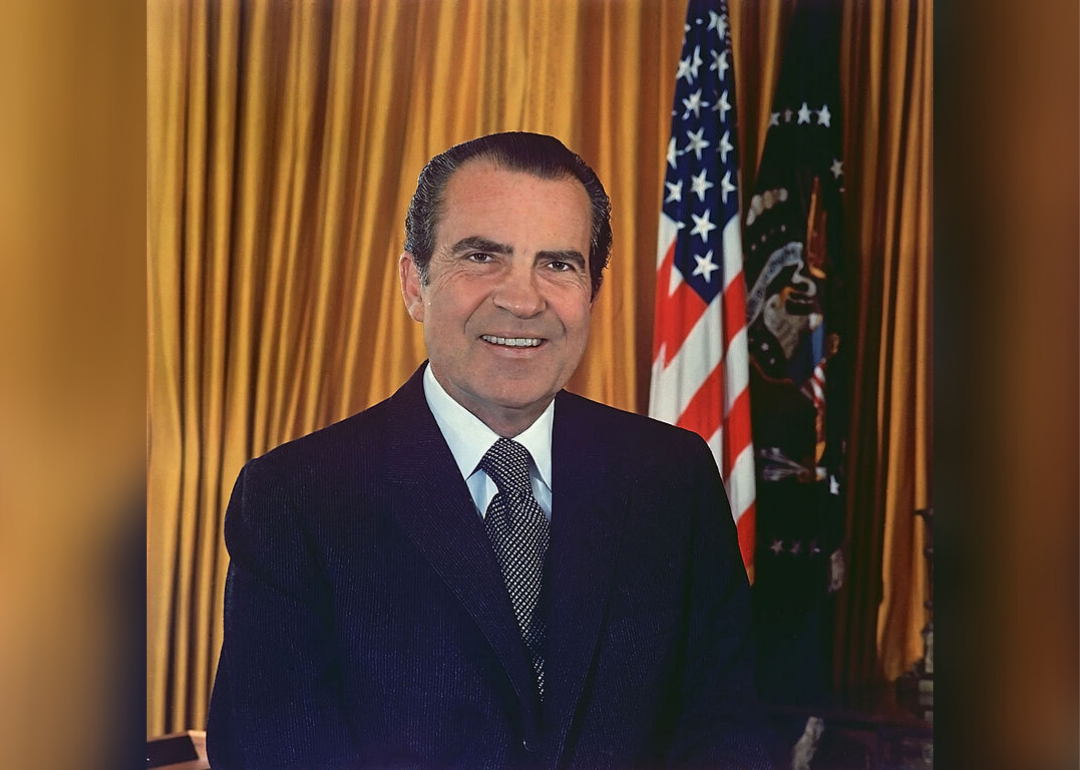
Public Domain // Wikimedia Commons
#21. Richard Nixon
– 37th president (Served: Jan. 20, 1969-Aug. 9, 1974)
– Political party: Republican
– Overall C-SPAN score: 464
— Political persuasion score: 48.2
— Crisis leadership score: 48.3
— Economic management score: 49.5
— Moral authority score: 21.7
— International relations score: 68.7
— Administrative skills score: 53.5
— Congressional relations score: 40.0
— Vision/ability to set an agenda score: 50.9
— Pursued equal justice for all score: 42.8
— Performance within context of the times score: 40.3
Richard Nixon may have ended U.S. involvement in the Vietnam War and improved diplomacy with the Soviet Union and China during his second term in office, but his legacy is inextricably tied to the Watergate scandal. After it was revealed that he had full knowledge of the break-in at the office headquarters of the Democratic National Committee in 1972, articles of impeachment were drawn up against Nixon. As a result, he resigned the presidency on Aug. 9, 1974, becoming the only president in U.S. history to resign from office.

Mandel Ngan // Getty Images
#20. George W. Bush
– 43rd president (Served: Jan. 20, 2001-Jan. 20, 2009)
– Political party: Republican
– Overall C-SPAN score: 495
— Political persuasion score: 51.1
— Crisis leadership score: 54.6
— Economic management score: 42.2
— Moral authority score: 51.4
— International relations score: 42.2
— Administrative skills score: 49.4
— Congressional relations score: 54.1
— Vision/ability to set an agenda score: 50.5
— Pursued equal justice for all score: 50.7
— Performance within context of the times score: 48.3
George W. Bush won his second term on the platform that his global war on terrorism policies kept the world a safer place. Bush’s high approval ratings after the 9/11 terror attacks are in sharp contrast to his bungled second term. His administration’s failed response to Hurricane Katrina, the wars in Iraq and Afghanistan, and a plunging economy that would result in the Great Recession of 2008 together made his presidency one of the most remarkable falls from public grace in U.S. history.
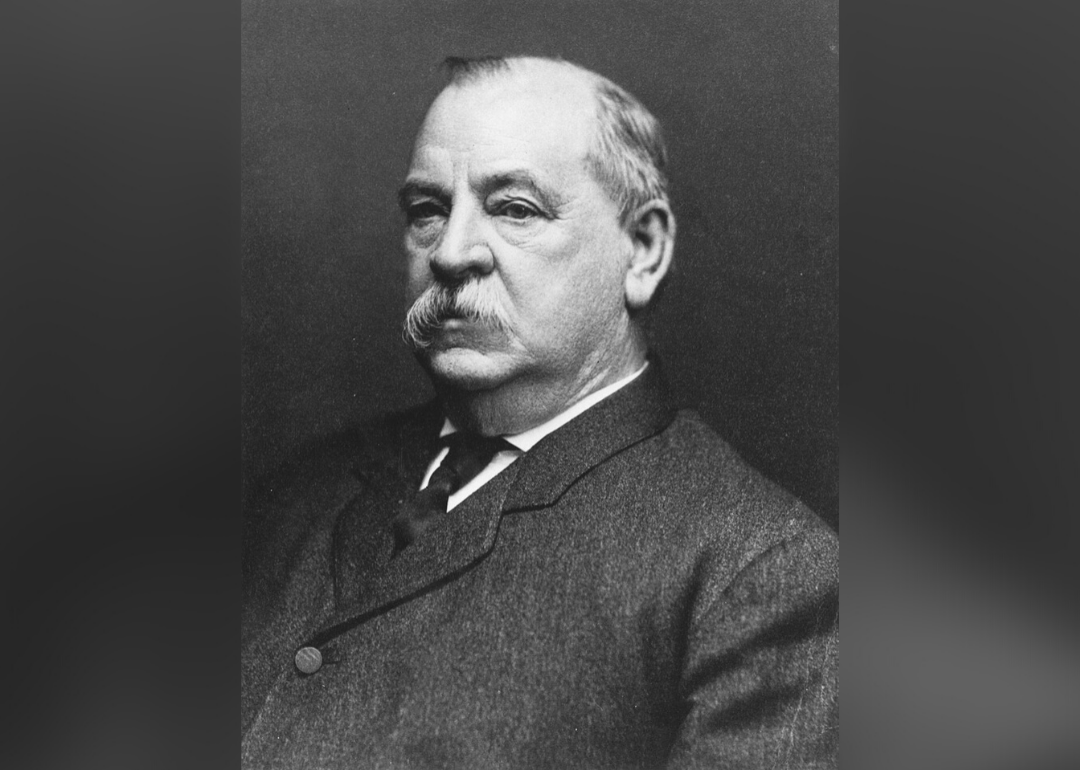
Public Domain // Wikimedia Commons
#19. Grover Cleveland
– 22nd, 24th president (Served: March 4, 1885-March 4, 1889; March 4, 1893-March, 4, 1897)
– Political party: Democratic
– Overall C-SPAN score: 523
— Political persuasion score: 55.5
— Crisis leadership score: 51.8
— Economic management score: 50.0
— Moral authority score: 53.5
— International relations score: 53.8
— Administrative skills score: 58.3
— Congressional relations score: 51.6
— Vision/ability to set an agenda score: 52.2
— Pursued equal justice for all score: 42.3
— Performance within context of the times score: 53.8
Grover Cleveland is the only second-term president who did not serve his terms consecutively. One of nine children born to a Presbyterian minister, Cleveland is also the only president to marry at the White House. The U.S. was suffering through an economic depression during Cleveland’s second term, and his policies during that time left him largely unpopular across the country.
When railroad strikers in Chicago acted in violation of a federal injunction, Cleveland ordered federal troops to the Windy City to quash the strike, resulting in national disapproval that eventually led the Democratic party to nominate another candidate for the 1896 election.
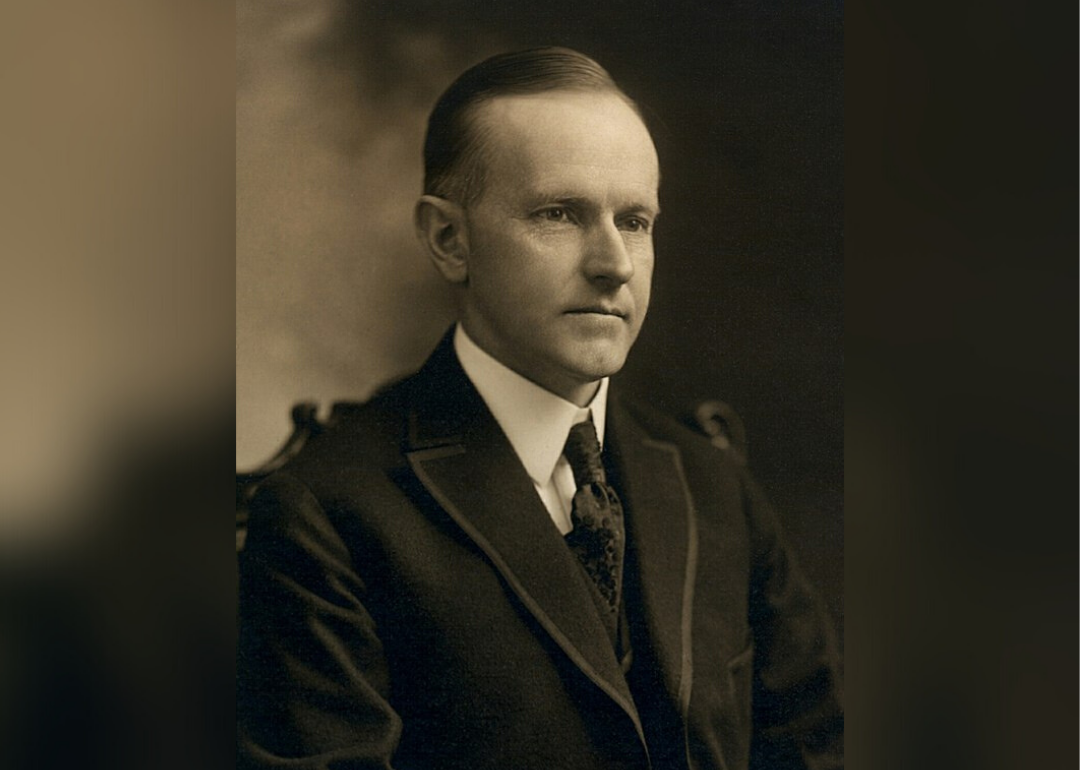
Public Domian // Wikimedia Commons
#18. Calvin Coolidge
– 30th president (Served: Aug. 2, 1923-March 4, 1929)
– Political party: Republican
– Overall C-SPAN score: 535
— Political persuasion score: 52.9
— Crisis leadership score: 49.1
— Economic management score: 56.0
— Moral authority score: 60.4
— International relations score: 52.0
— Administrative skills score: 59.6
— Congressional relations score: 57.4
— Vision/ability to set an agenda score: 48.5
— Pursued equal justice for all score: 44.3
— Performance within context of the times score: 55.2
Calvin Coolidge became president after the sudden death of his predecessor Warren G. Harding. Coolidge strongly felt all Americans should be treated equally, once proclaiming, “No matter by what various crafts we came here, we are all now in the same boat.” During Coolidge’s presidency, Americans were introduced to electricity, radio, and the first widely available automobiles. Coolidge was a lawyer, though he never attended law school, which was not entirely uncommon at that time. When he left office in 1929, he had successfully balanced the federal budget each year of his administration.
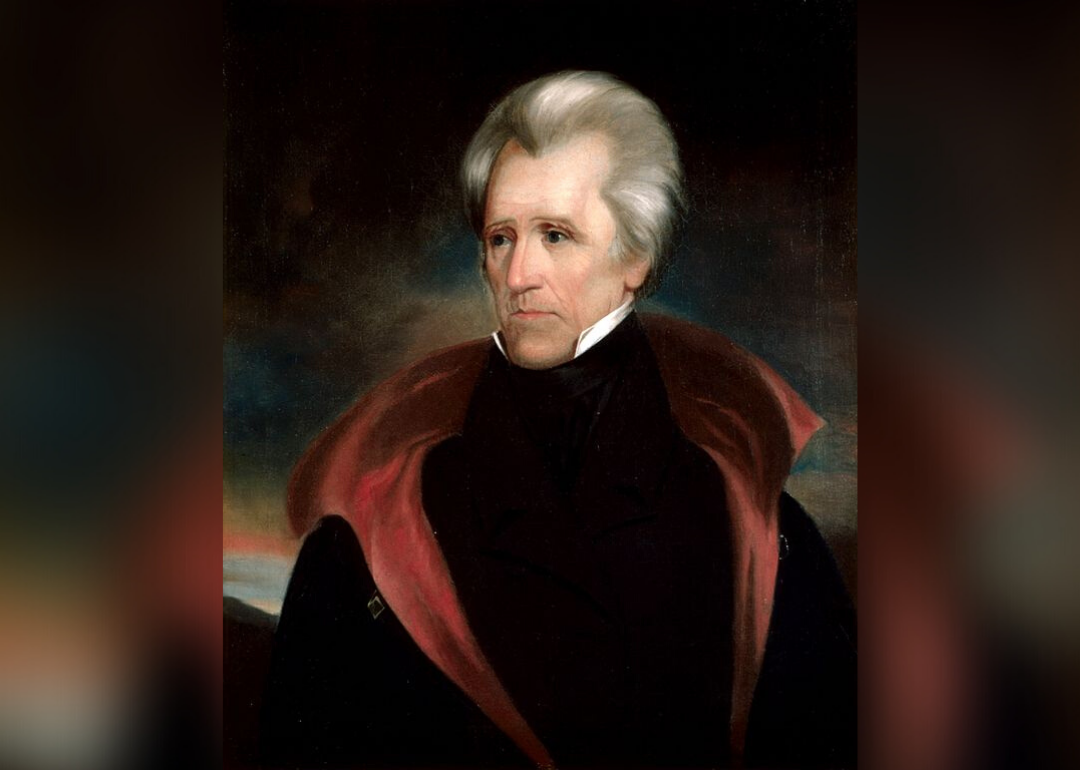
Public Domain // Wikimedia Commons
#17. Andrew Jackson
– 7th president (Served: March 4, 1829-March 4, 1837)
– Political party: Democratic
– Overall C-SPAN score: 568
— Political persuasion score: 78.6
— Crisis leadership score: 66.5
— Economic management score: 49.3
— Moral authority score: 46.3
— International relations score: 55.5
— Administrative skills score: 53.5
— Congressional relations score: 51.9
— Vision/ability to set an agenda score: 74.1
— Pursued equal justice for all score: 30.0
— Performance within context of the times score: 62.8
Andrew Jackson once killed a man in a duel defending his wife’s honor; he nearly died himself as a result. Though dueling was technically illegal in the United States (even back in the early 1800s), politicians used it widely to settle disputes. Jackson is rumored to have been in over 100 duels. Jackson won his second term in a landslide, amassing 219 electoral votes to his opponent’s 49. During his second term, Jackson’s policies paved the way for the federal government to pay off all its debt and return surplus funds to the states. Unfortunately, this led directly to the Panic of 1837 and one of the hardest recessions in U.S. history.
You may also like: Political cartoons from the last 111 years
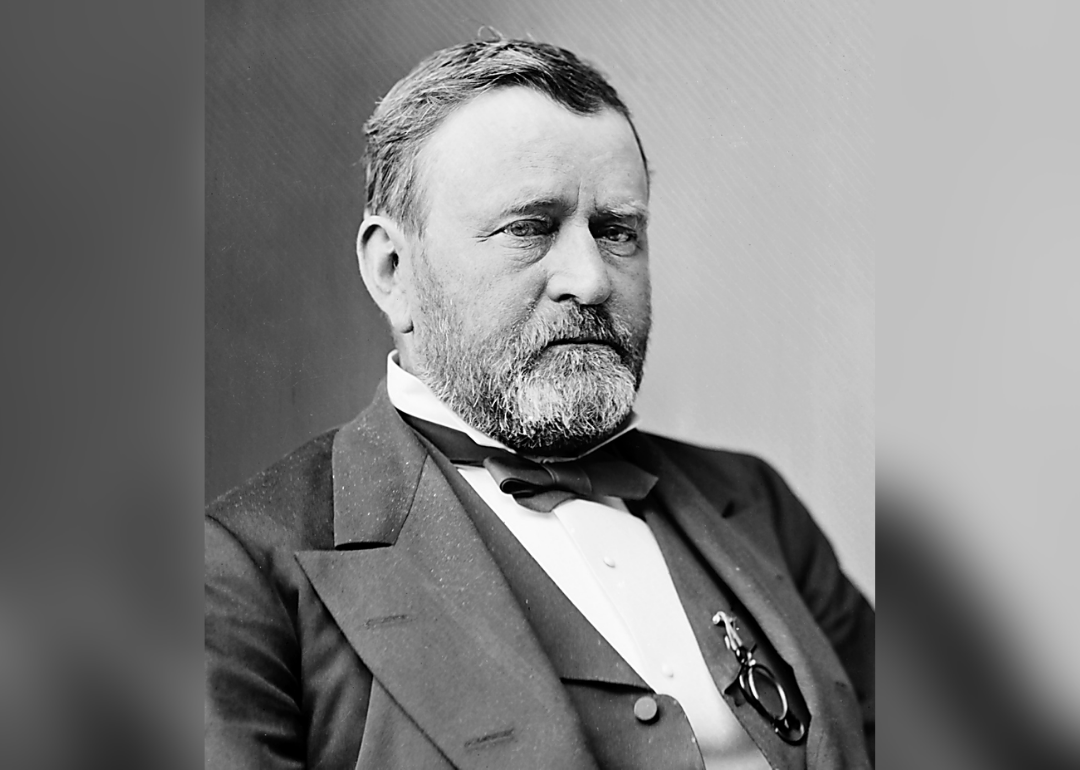
Public Domain // Wikimedia Commons
#16. Ulysses S. Grant
– 18th president (Served: March 4, 1869-March 4, 1877)
– Political party: Republican
– Overall C-SPAN score: 590
— Political persuasion score: 61.9
— Crisis leadership score: 63.2
— Economic management score: 47.5
— Moral authority score: 60.8
— International relations score: 61.5
— Administrative skills score: 46.1
— Congressional relations score: 56.7
— Vision/ability to set an agenda score: 58.1
— Pursued equal justice for all score: 71.4
— Performance within context of the times score: 63.1
Before becoming president, Ulysses S. Grant commanded the Union army in its victory over the Confederacy in the Civil War. Though Grant grew up in an abolitionist household in Ohio, he became an enslaver when he married his wife, Julia Dent, and took on her family’s estate. Grant was the last president to claim ownership of enslaved persons.
During his two terms in office, Grant oversaw the creation of the Department of Justice and the passage of the 15th Amendment allowing African American men the right to vote. The Panic of 1873 was an unfortunate detriment to Grant’s second term, though during this time the country went through its first Civil Rights movement following the passage of the Civil Right Act of 1866.

Ira Wyman // Getty Images
#15. Bill Clinton
– 42nd president (Served: Jan. 20, 1993-Jan. 20, 2001)
– Political party: Democratic
– Overall C-SPAN score: 594
— Political persuasion score: 73.4
— Crisis leadership score: 57.7
— Economic management score: 73.6
— Moral authority score: 30.0
— International relations score: 58.7
— Administrative skills score: 59.4
— Congressional relations score: 52.2
— Vision/ability to set an agenda score: 60.2
— Pursued equal justice for all score: 66.6
— Performance within context of the times score: 61.9
Bill Clinton’s second-term accomplishments are largely overshadowed by his affair with White House intern Monica Lewinsky. Clinton was the second president to be impeached, after Andrew Jackson. (Articles of impeachment were drawn up against Richard Nixon, but he resigned the presidency before the House could cast a vote.) Clinton’s birth name is William Jefferson Blythe III. Clinton is named after his biological father who died a few months before Clinton’s birth. He took his stepfather’s last name during his teens.
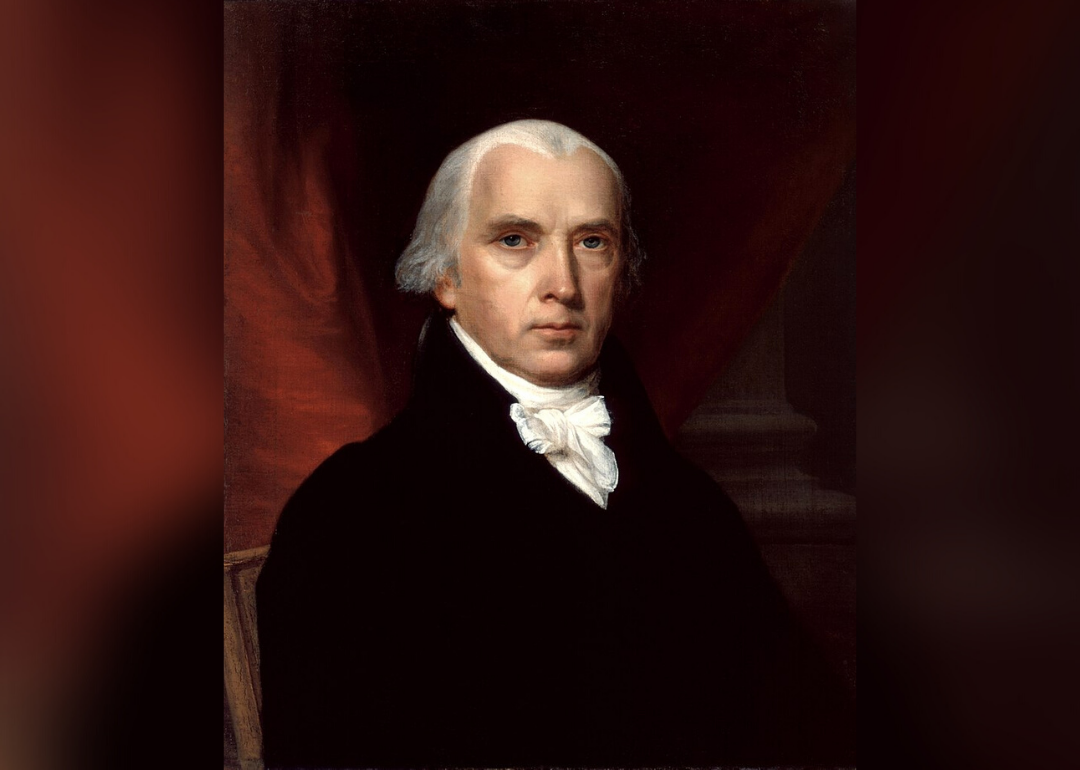
Public Domain // Wikimedia Commons
#14. James Madison
– 4th president (Served: March 4, 1809-March 4, 1817)
– Political party: Democratic-Republican
– Overall C-SPAN score: 604
— Political persuasion score: 60.5
— Crisis leadership score: 60.4
— Economic management score: 57.1
— Moral authority score: 68.5
— International relations score: 56.0
— Administrative skills score: 62.0
— Congressional relations score: 60.9
— Vision/ability to set an agenda score: 66.4
— Pursued equal justice for all score: 47.1
— Performance within context of the times score: 65.3
James Madison is known to this day as the “Father of the Constitution,” though it was a moniker he disliked on the basis that the Constitution was not, to his mind, “the offspring of a single brain,” but rather the “work of many heads and many hands.” Madison faced sowing discontent with Great Britain, declaring “non-intercourse” with the country in 1810.
Not long thereafter, after cargo and American seamen were detained by British forces, Madison declared war against Great Britain, beginning the War of 1812. After he won reelection, Madison ordered U.S. troops to invade Canada, then a British colony. In August 1814, British troops marched into Washington D.C. and set fire to the White House in retaliation for the burning of the Canadian Parliament buildings. Nonetheless, the war ended four months later.
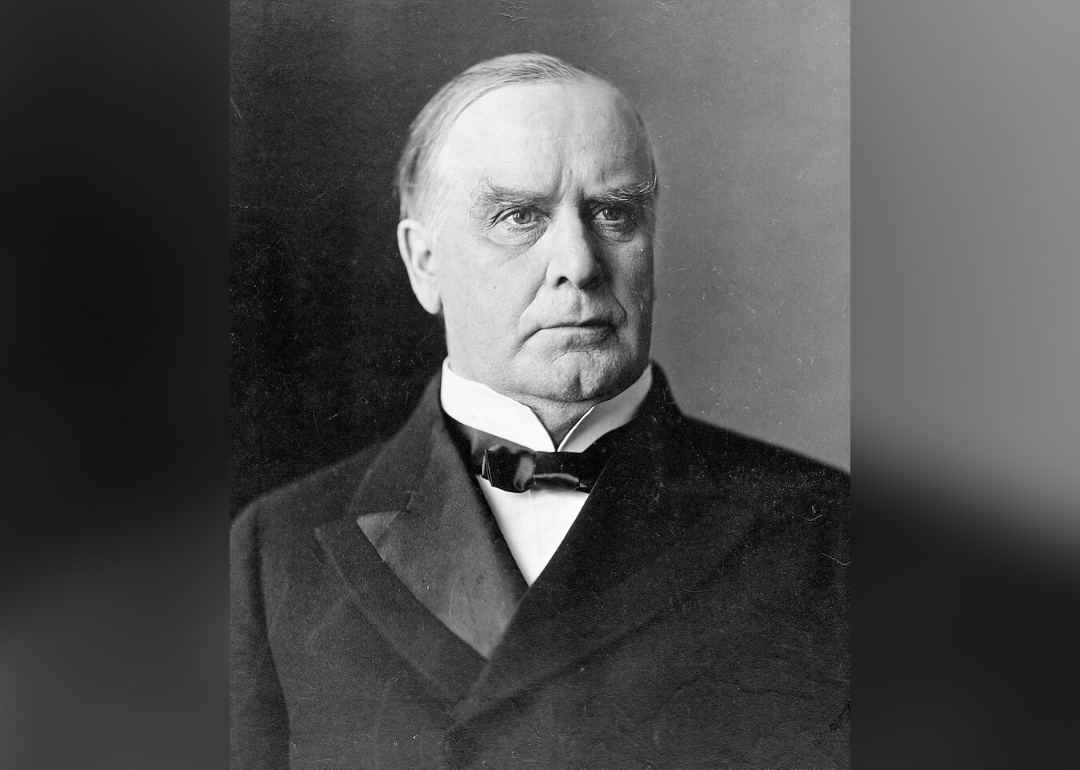
Publid Domain // Wikimedia Commons
#13. William McKinley
– 25th president (Served: March 4, 1897-Sept. 14, 1901)
– Political party: Republican
– Overall C-SPAN score: 612
— Political persuasion score: 64.2
— Crisis leadership score: 63.4
— Economic management score: 62.1
— Moral authority score: 59.4
— International relations score: 64.2
— Administrative skills score: 64.2
— Congressional relations score: 65.2
— Vision/ability to set an agenda score: 62.3
— Pursued equal justice for all score: 43.8
— Performance within context of the times score: 63.4
William McKinley was assassinated during his second term in office. During a stop at the Pan-American Exposition in Buffalo, New York, he was shot twice by anarchist Leon Czolgosz. Czolgosz was sentenced to death and executed less than two months after McKinley’s death. For decades, McKinley’s presidency was considered average at best, but more recently presidential historians argue it was McKinley who first put the United States on the path to becoming a world superpower.
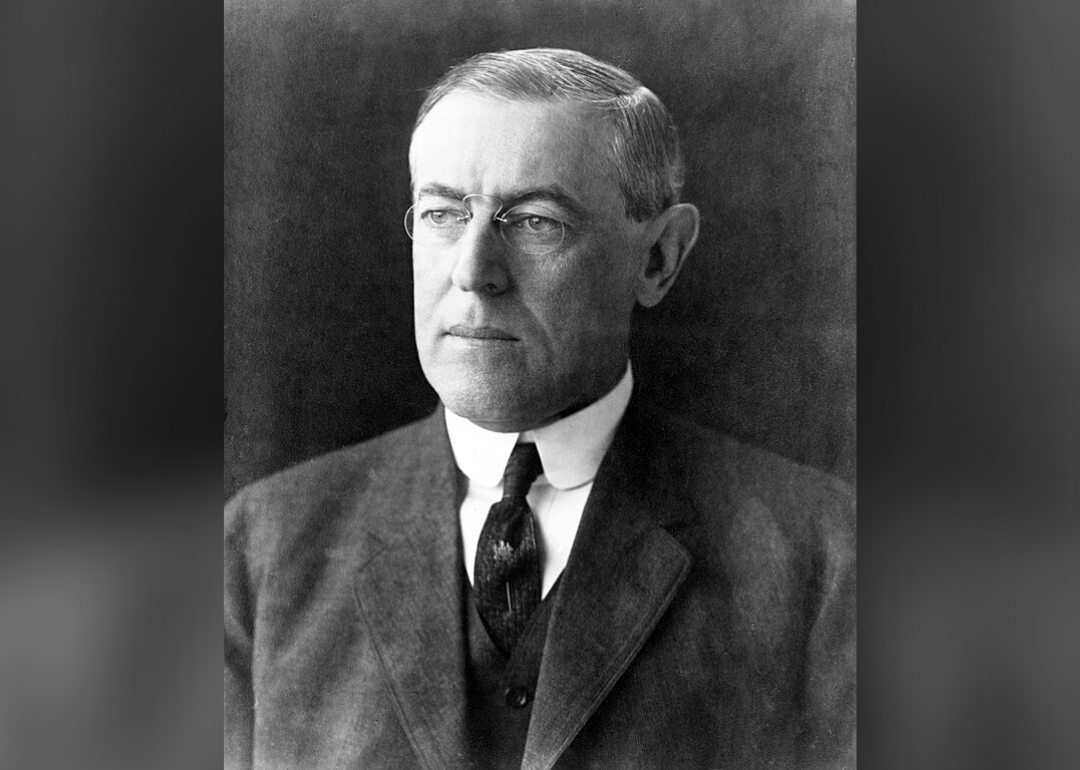
Pach Brothers // Wikimedia Commons
#12. Woodrow Wilson
– 28th president (Served: March 4, 1913-March 4, 1921)
– Political party: Democratic
– Overall C-SPAN score: 617
— Political persuasion score: 72.4
— Crisis leadership score: 67.1
— Economic management score: 62.1
— Moral authority score: 59.6
— International relations score: 67.8
— Administrative skills score: 64.4
— Congressional relations score: 55.0
— Vision/ability to set an agenda score: 75.5
— Pursued equal justice for all score: 30.2
— Performance within context of the times score: 63.2
Despite the desire to remain neutral, Woodrow Wilson’s second term was dominated by the U.S.’s entry into World War I. At the war’s end, Wilson was an integral part of the Paris Peace Talks and the establishment of the League of Nations, which lasted through the end of World War II. Another first during Wilson’s administration was the first-ever presidential press conference, which has now become a staple of the executive branch. Wilson also supported the expansion of Jim Crow laws, racially segregated the federal government, and initially blocked the women’s suffrage movement.
You may also like: Iconic presidential photos from the year you were born
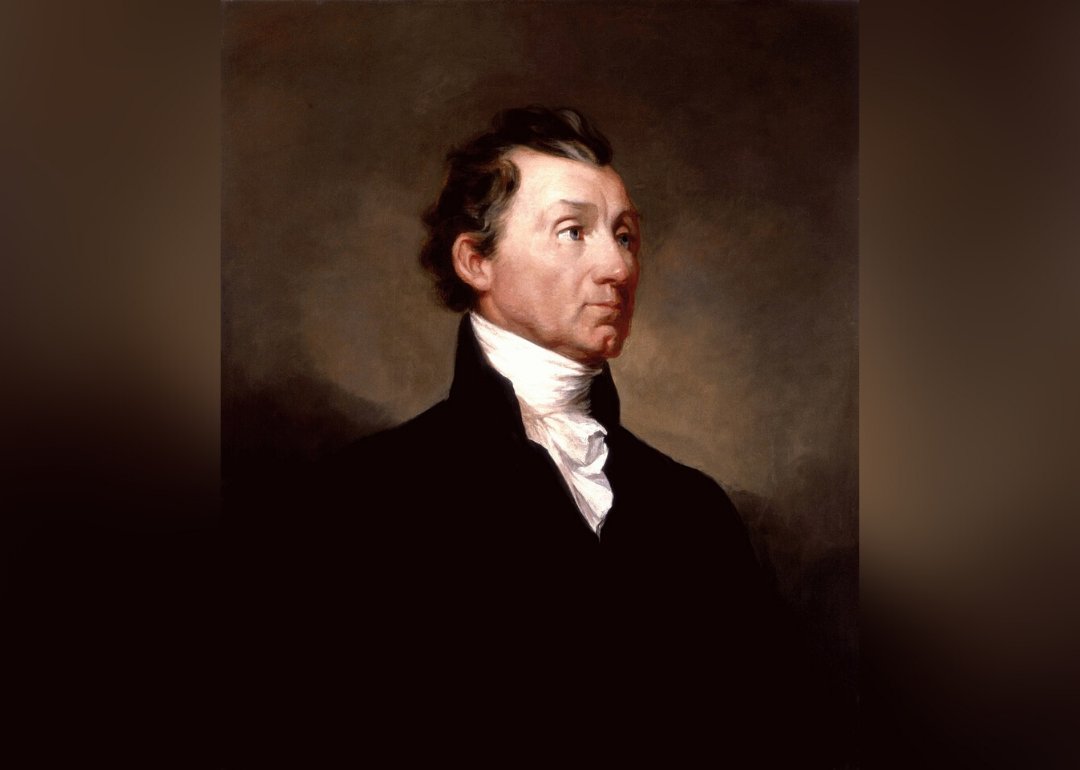
Public Domain // Wikimedia Commons
#11. James Monroe
– 5th president (Served: March 4, 1817-March 4, 1825)
– Political party: Democratic-Republican
– Overall C-SPAN score: 643
— Political persuasion score: 63.5
— Crisis leadership score: 64.9
— Economic management score: 59.9
— Moral authority score: 63.2
— International relations score: 78.4
— Administrative skills score: 66.5
— Congressional relations score: 66.9
— Vision/ability to set an agenda score: 68.6
— Pursued equal justice for all score: 43.9
— Performance within context of the times score: 67.8
During his second term and seventh annual congressional address, James Monroe introduced a foreign policy now known as the “Monroe Doctrine,” in which he warned European governments not to interfere with the affairs of nations in the Western Hemisphere, notably the U.S. While Monroe supported abolition during his presidency, he also enslaved as many as 250 people during his life. Surprisingly, in light of this fact, the African nation of Liberia, which was founded by formerly enslaved Americans, named its capital, Monrovia, for him after he supported their repatriation. Monroe’s last request on his deathbed was to grant freedom to one person he enslaved, Peter Marks.
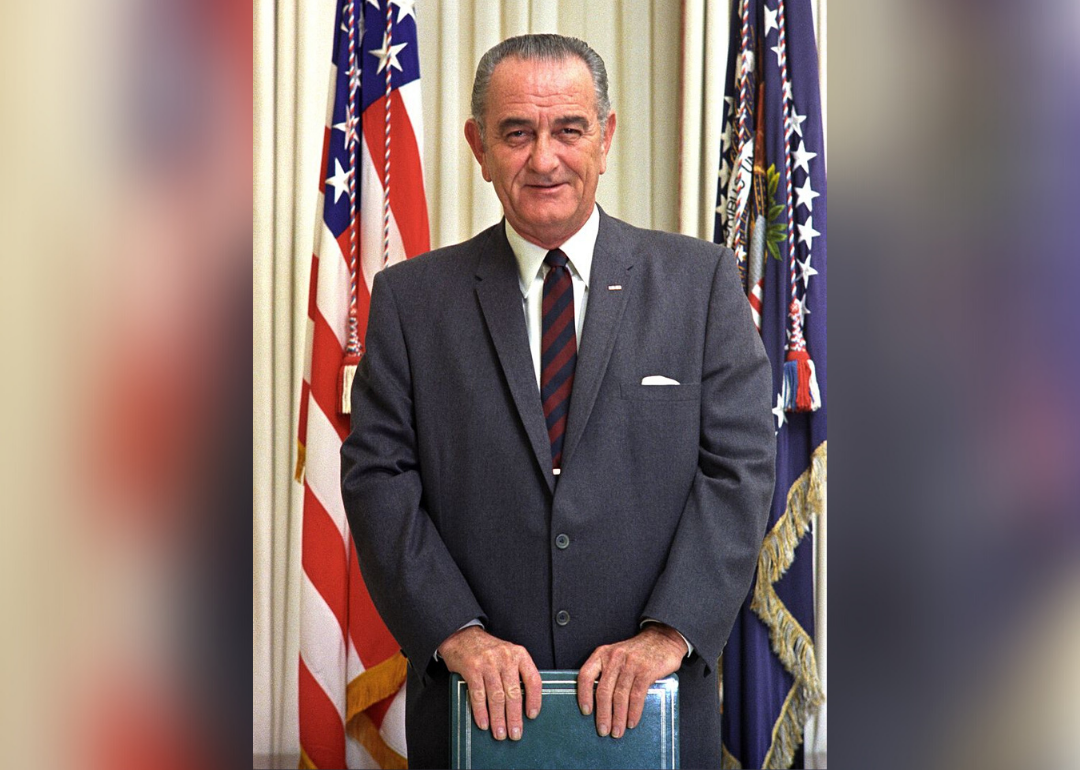
Yoichi Okamoto // Wikimedia Commons
#10. Lyndon B. Johnson
– 36th president (Served: Nov. 22, 1963-Jan. 20, 1969)
– Political party: Democratic
– Overall C-SPAN score: 654
— Political persuasion score: 64.1
— Crisis leadership score: 57.5
— Economic management score: 58.5
— Moral authority score: 54.8
— International relations score: 39.7
— Administrative skills score: 68.9
— Congressional relations score: 80.7
— Vision/ability to set an agenda score: 78.1
— Pursued equal justice for all score: 86.2
— Performance within context of the times score: 65.0
Lyndon Baines Johnson ascended to the presidency in the immediate wake of the assassination of John F. Kennedy in November 1963. During Johnson’s second term, America’s involvement in the Vietnam War raged on, with troop levels growing each year. As the war intensified and public support continued to erode, Johnson began to believe that an end to the war would not be possible without a change in leadership. Consequently, during a national address, Johnson shocked the country when he announced on live TV that he would not seek reelection.

Dominick Reuter // Getty Images
#9. Barack Obama
– 44th president (Served: Jan. 20, 2009-Jan. 20, 2017)
– Political party: Democratic
– Overall C-SPAN score: 664
— Political persuasion score: 76.3
— Crisis leadership score: 62.8
— Economic management score: 64.6
— Moral authority score: 75.5
— International relations score: 56.7
— Administrative skills score: 63.3
— Congressional relations score: 46.9
— Vision/ability to set an agenda score: 71.5
— Pursued equal justice for all score: 78.2
— Performance within context of the times score: 68.2
Barack Obama was the first and, to date, only Black president in American history. Known for his eloquent dialogue and inspiring speeches, Obama was awarded the Nobel Peace Prize in 2009. In 2016, during his second term in office, Obama traveled to Cuba, the first sitting U.S. president to do so in 88 years. Perhaps his most enduring impact on American society came in the form of the Affordable Care Act—typically referred to as “Obamacare”—which enabled millions of people to get health insurance who would otherwise not be able to afford it. It is estimated that the ACA has helped more than 35 million people get insured.
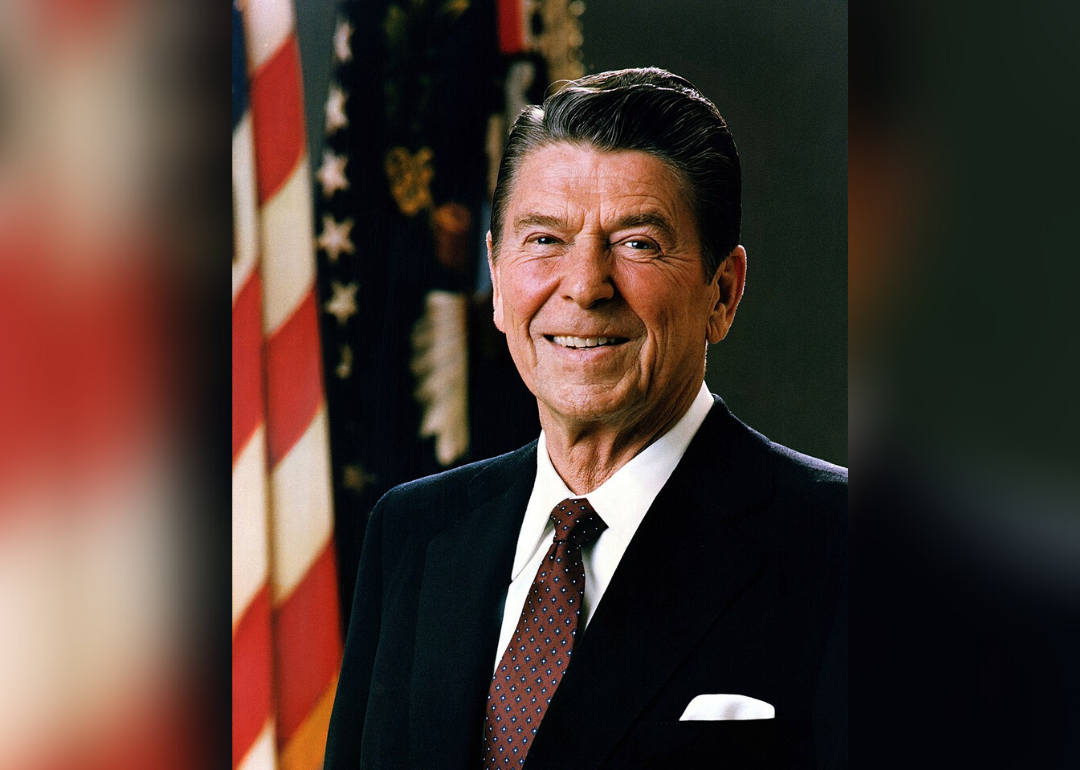
Public Domain // Wikimedia Commons
#8. Ronald Reagan
– 40th president (Served: Jan. 20, 1981-Jan. 20, 1989)
– Political party: Republican
– Overall C-SPAN score: 681
— Political persuasion score: 89.1
— Crisis leadership score: 69.0
— Economic management score: 60.5
— Moral authority score: 65.4
— International relations score: 73.8
— Administrative skills score: 52.1
— Congressional relations score: 68.4
— Vision/ability to set an agenda score: 84.0
— Pursued equal justice for all score: 46.0
— Performance within context of the times score: 73.0
Before turning to politics, Ronald Reagan was a successful actor and served as the president of the Screen Actors Guild. He was elected to the California governorship in 1966 and again in 1970, a precursor to his eventual presidential run. Reagan easily won his second presidential term amid the country’s growing economic prosperity under his leadership; however, his legacy was marred by his authorization of the sale of weapons to Iran in exchange for help with American hostages in Lebanon, a catastrophe now known as the Iran-Contra Affair.
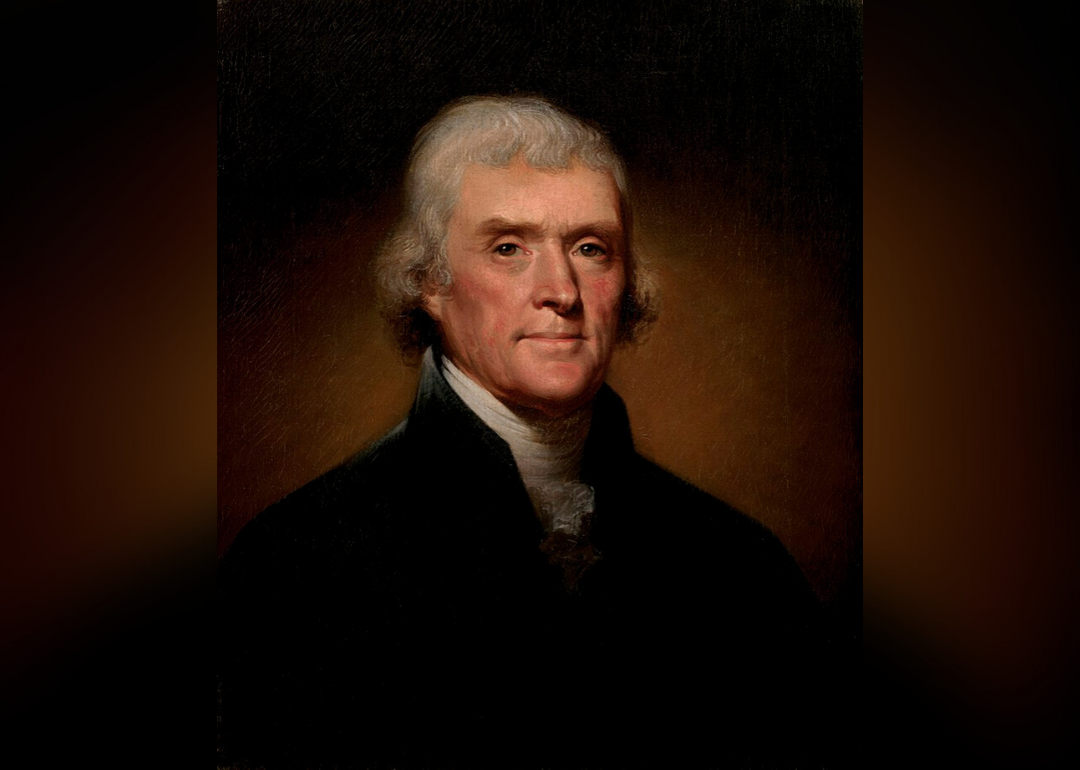
Public Domain // Wikimedia Commons
#7. Thomas Jefferson
– 3rd president (Served: March 4, 1801-March 4, 1809)
– Political party: Democratic-Republican
– Overall C-SPAN score: 704
— Political persuasion score: 79.6
— Crisis leadership score: 70.2
— Economic management score: 62.4
— Moral authority score: 69.1
— International relations score: 69.2
— Administrative skills score: 72.1
— Congressional relations score: 73.0
— Vision/ability to set an agenda score: 83.8
— Pursued equal justice for all score: 47.9
— Performance within context of the times score: 77.1
Thomas Jefferson almost wasn’t president at all. His assumption of the chief executive’s office was the result of a tie vote between Jefferson and Aaron Burr that was settled by the House of Representatives. He spent much of his second term trying to keep the U.S. out of the Napoleonic Wars, despite French and British aggression toward American mercantilism.
Though he wrote in personal letters that slavery was evil, Jefferson claimed ownership of over 600 enslaved people throughout his life and is only known to have granted freedom to 10 of them. It may be surprising then that Jefferson convinced Congress to pass legislation officially banning the African slave trade in 1807.
You may also like: Voter demographics of every state
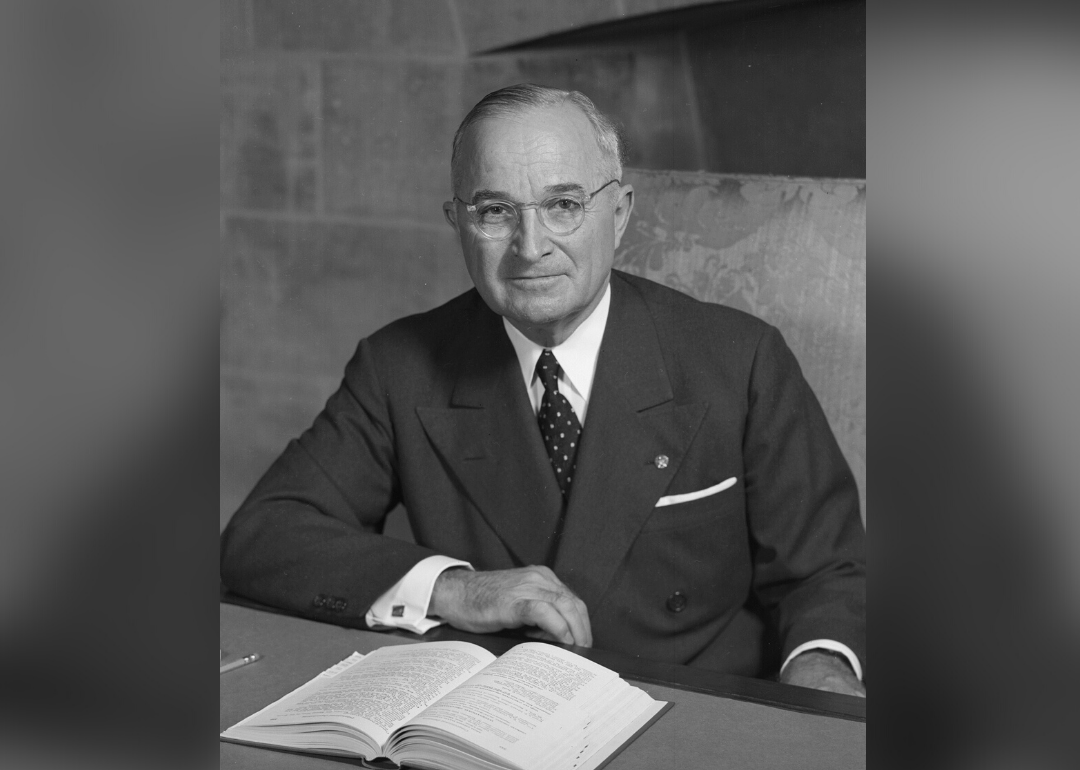
Public Domain // Wikimedia Commons
#6. Harry S. Truman
– 33rd president (Served: April 12, 1945-Jan. 20, 1953)
– Political party: Democratic
– Overall C-SPAN score: 713
— Political persuasion score: 65.5
— Crisis leadership score: 80.1
— Economic management score: 67.6
— Moral authority score: 71.3
— International relations score: 78.3
— Administrative skills score: 68.0
— Congressional relations score: 59.6
— Vision/ability to set an agenda score: 69.8
— Pursued equal justice for all score: 75.3
— Performance within context of the times score: 77.4
Before politics, Harry Truman worked various jobs as a farmer, bank clerk, sewing store manager, and county judge. Truman was sworn in as president following Franklin D. Roosevelt’s death in April 1945, while the Second World War was still ongoing. While he was lionized for successfully ending the war in victory, Truman’s popularity sank during his second term after his administration was plagued with allegations of corruption and being “soft on communism,” a rising concern in the U.S. that would soon thereafter result in the trials of the House Un-American Activities Committee.
Truman chose not to run for reelection at the end of his second term. Interestingly, the one fact about Truman that to this day still rings with controversy is his name—more specifically his middle initial. When he was born, Truman’s parents couldn’t agree on a middle name and compromised simply on “S,” though it does not denote an actual given name.
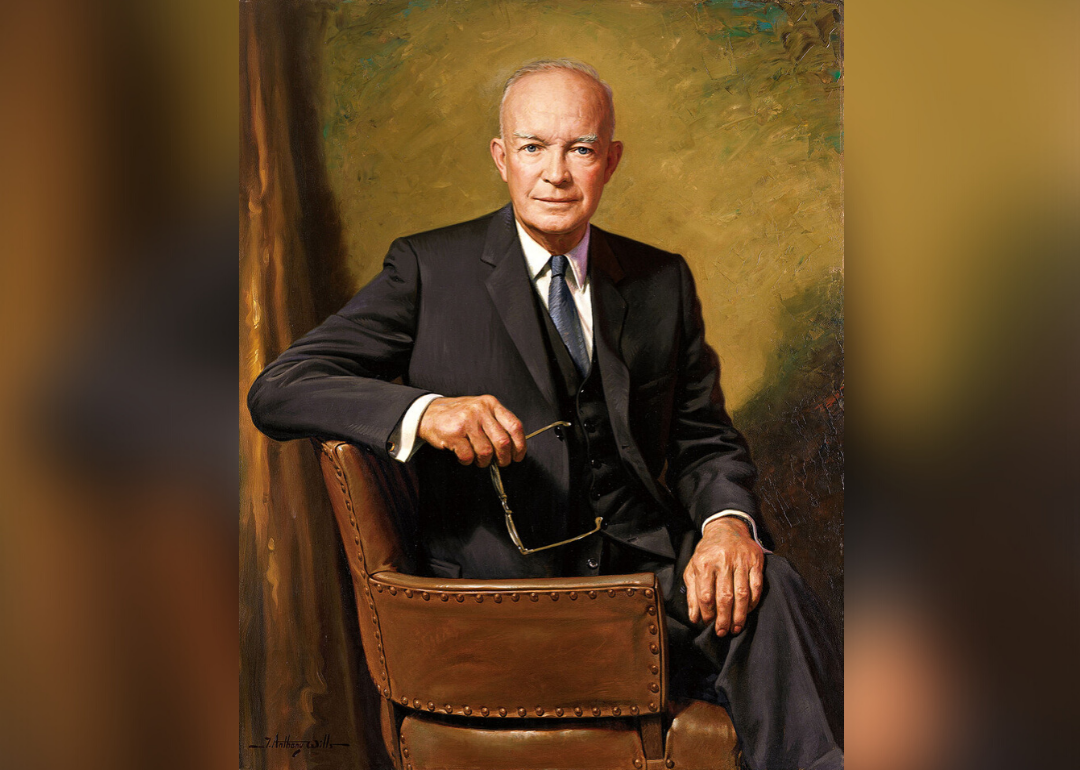
James Anthony Wills // Wikimedia Commons
#5. Dwight D. Eisenhower
– 34th president (Served: Jan. 20, 1953-Jan. 20, 1961)
– Political party: Republican
– Overall C-SPAN score: 734
— Political persuasion score: 73.3
— Crisis leadership score: 77.3
— Economic management score: 72.3
— Moral authority score: 81.4
— International relations score: 78.5
— Administrative skills score: 76.1
— Congressional relations score: 72.4
— Vision/ability to set an agenda score: 64.8
— Pursued equal justice for all score: 61.5
— Performance within context of the times score: 76.0
Ike’s second term started with one crisis after another. While he pushed for more civil rights legislation, Arkansas Gov. Orval Faubus tried to prevent nine Black students from attending a racially segregated school in Little Rock in 1954. The country soon went into recession in 1957, and Eisenhower was further criticized for losing the space race after Russia launched the first artificial satellite—Sputnik. Eisenhower’s health became a concern midway through his second term when he suffered a stroke sitting at his desk. Nonetheless, he is remembered for the creation of the National Highway System and for seeing the nation through the Korean War.
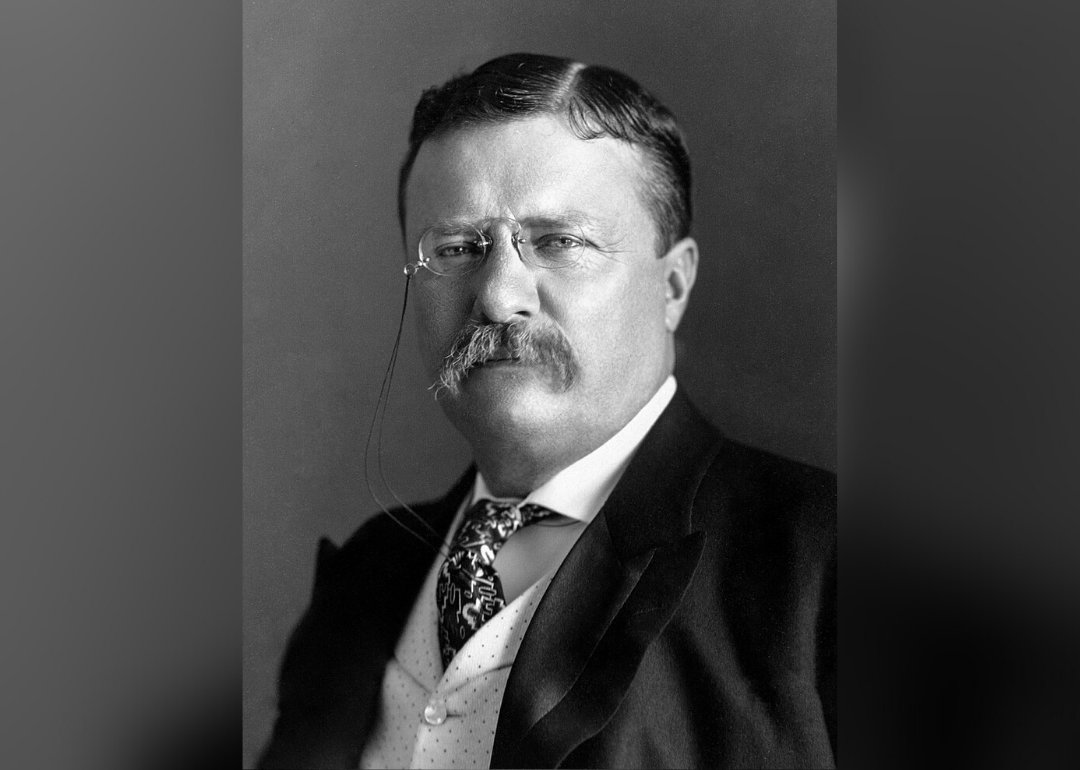
Patch Bros // Wikimedia Commons
#4. Theodore Roosevelt
– 26th president (Served: Sept. 14, 1901-March 4, 1909)
– Political party: Republican
– Overall C-SPAN score: 785
— Political persuasion score: 90.3
— Crisis leadership score: 80.8
— Economic management score: 75.0
— Moral authority score: 79.3
— International relations score: 80.6
— Administrative skills score: 75.0
— Congressional relations score: 71.6
— Vision/ability to set an agenda score: 86.9
— Pursued equal justice for all score: 62.7
— Performance within context of the times score: 82.5
Theodore Roosevelt was only 42 when he assumed the presidency after President McKinley’s assassination, making him the youngest person ever to hold the office. Roosevelt used the proverb “speak softly and carry a big stick” as his mantra for global diplomacy. Remembered as the “conservation president,” Roosevelt federally protected over 230 million acres of public land while in office.
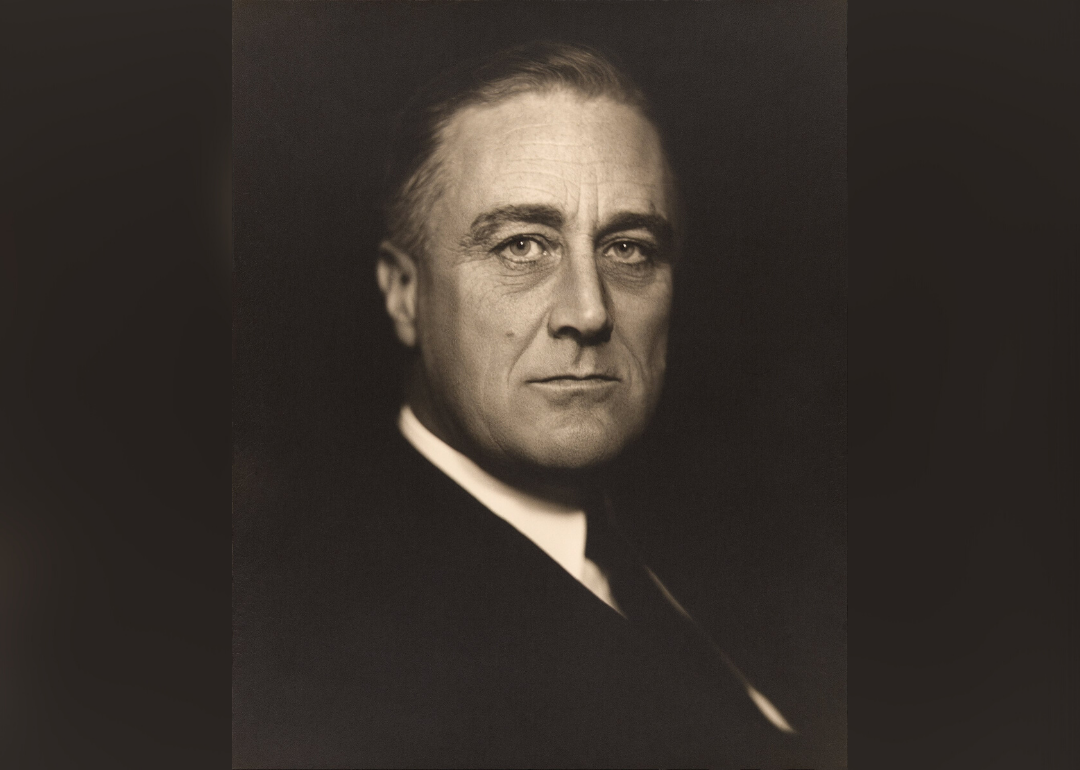
Vincenzo Laviosa // Wikimedia Commons
#3. Franklin D. Roosevelt
– 32nd president (Served: March 4, 1933-April 12, 1945)
– Political party: Democratic
– Overall C-SPAN score: 841
— Political persuasion score: 94.8
— Crisis leadership score: 91.6
— Economic management score: 75.4
— Moral authority score: 81.8
— International relations score: 88.0
— Administrative skills score: 80.7
— Congressional relations score: 80.5
— Vision/ability to set an agenda score: 92.0
— Pursued equal justice for all score: 66.2
— Performance within context of the times score: 89.6
Franklin D. Roosevelt faced a great number of difficulties during his 12 years in office, most notably the Great Depression followed swiftly by World War II. His New Deal programs were much maligned by political adversaries, but they were effective at pulling America out of the Great Depression. Among the programs established under the New Deal that still exist today are Social Security, farm subsidies, unemployment insurance, and the Securities and Exchange Commission.
His “Day of Infamy” speech on Dec. 8, 1941, the day after Japan’s attack on Pearl Harbor, propelled the United States into WWII after more than two years of neutrality. Roosevelt died in his 12th year in office, just months after starting his fourth term. The ratification of the 22nd Amendment several years later, in 1951, prevented future presidents from serving more than two four-year terms.
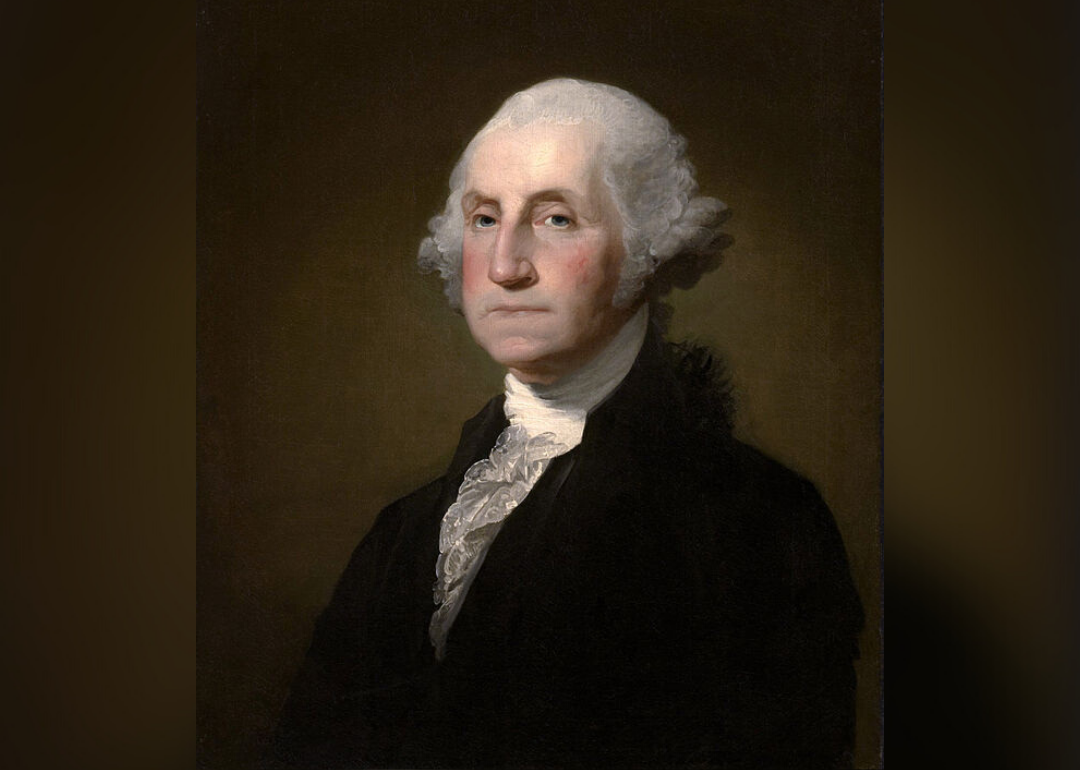
Public Domain // Wikimedia Commons
#2. George Washington
– 1st president (Served: April 30, 1789-March 4, 1797)
– Political party: Independent
– Overall C-SPAN score: 851
— Political persuasion score: 89.9
— Crisis leadership score: 91.9
— Economic management score: 80.5
— Moral authority score: 92.7
— International relations score: 85.0
— Administrative skills score: 84.0
— Congressional relations score: 83.5
— Vision/ability to set an agenda score: 93.1
— Pursued equal justice for all score: 54.8
— Performance within context of the times score: 95.6
The first U.S. president was deeply embarrassed by his limited formal schooling. Fellow founding father John Adams once famously claimed Washington was “too illiterate” for the presidency. Washington was, however, extremely wealthy. He owned a whiskey distillery, producing as much as 11,000 gallons of whiskey a year. His marriage to wife Martha further increased his wealth—and the number of persons he enslaved.
Like many other elected officials who would follow him, Washington struggled with the hypocrisy of the slave trade. Washington first became an enslaver at age 11 and remained so for over 50 years. At the time of his death, he decreed that all enslaved persons at Mount Vernon be freed upon the eventual death of his wife.
You may also like: What a Roe v. Wade reversal could mean for abortion access across America
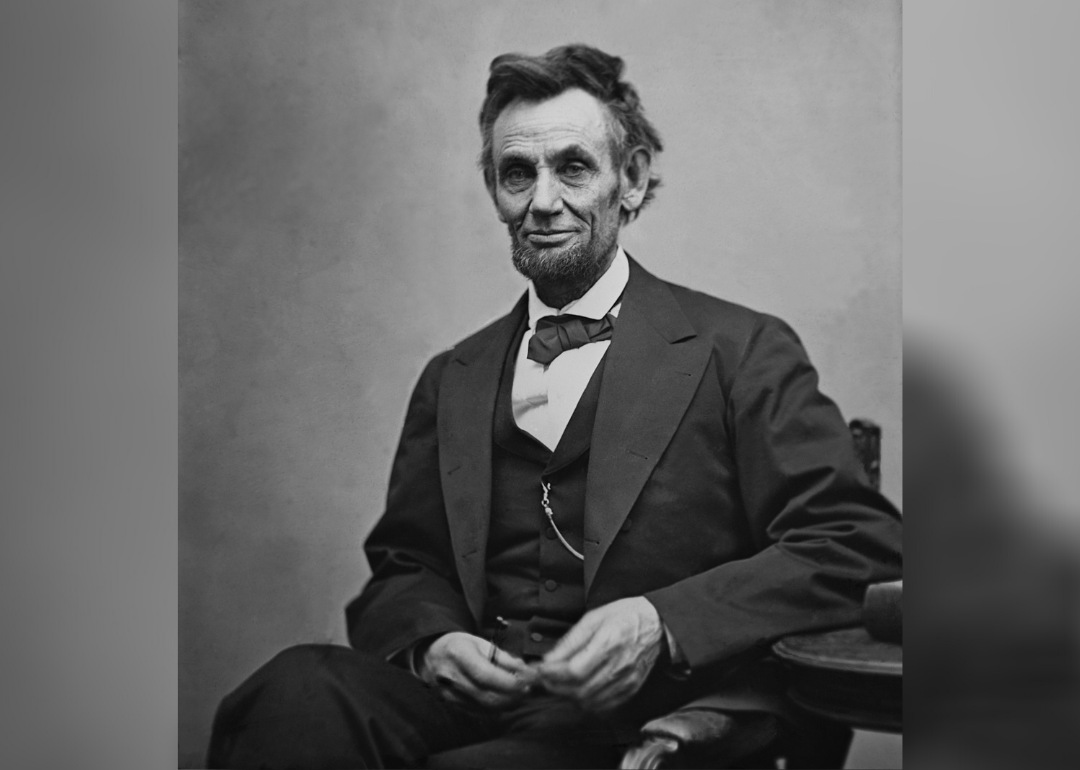
Canva
#1. Abraham Lincoln
– 16th president (Served: March 4, 1861-April 15, 1865)
– Political party: Republican
– Overall C-SPAN score: 897
— Political persuasion score: 91.5
— Crisis leadership score: 96.4
— Economic management score: 81.9
— Moral authority score: 95.2
— International relations score: 82.8
— Administrative skills score: 86.7
— Congressional relations score: 78.9
— Vision/ability to set an agenda score: 96.4
— Pursued equal justice for all score: 90.9
— Performance within context of the times score: 96.5
On Jan. 1, 1863, two years into his first term, Abraham Lincoln issued the Emancipation Proclamation, declaring the freedom of all enslaved peoples. The Civil War had been raging at that point since six weeks into Lincoln’s presidency. Lincoln’s time in office was entirely occupied by the war, and he only survived the first overture of its conclusion by a few days but never saw its complete cessation.
One month into Lincoln’s second term, in April 1865, five days after the articles of surrender were issued by Robert E. Lee, John Wilkes Booth shot the president in the back of the head at Ford’s Theatre in Washington D.C. In a cruel and fascinating twist of fate, a photograph of Lincoln’s second inauguration shows his would-be assassin standing within firing range of the president.